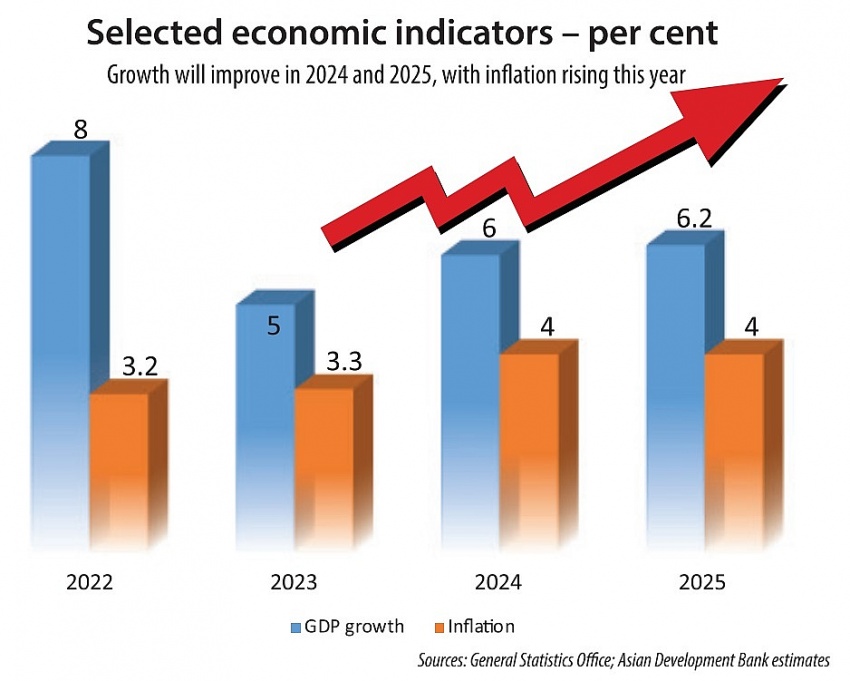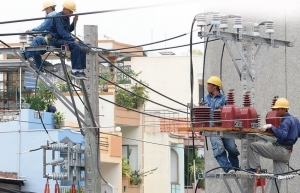Inflation pressure to potentially moderate for Vietnam
It is expected that the domestic electricity price will increase soon as a mechanism to adjust the average electricity retail price in Vietnam took effect on May 15.
 |
Under the move, the electricity price is allowed to be revised every three months. Last year, Vietnam Electricity (EVN) increased the price twice, at 3 and 4.5 per cent in May and November respectively, citing great losses due to a rise in many types of input costs.
Fresh figures from EVN indicated that it suffered from losses of about $1.21 billion cumulatively in the first half of 2023, higher than the $691 million loss in the same period of 2022. In 2022, the net loss reached $927.3 million.
According to the General Statistics Office, a hike in power prices contributed to an on-year rise of 3.25 per cent in the consumer price index (CPI) last year. Specifically, the price of household electricity rose 4.86 per cent, leading to a 0.16 per cent increase. In Q1 2024, a 9.38 per cent rise in electricity caused a 0.31 per cent increase in CPI, which climbed 3.77 per cent on-year.
Vietnam’s inflation for April rose 4.4 per cent on-year, far higher than the on-year climb of 2.81 per cent in the same period last year, the General Statistics Office (GSO) stated.
One of the key driver of April inflation is an on-year increase of 0.27 per cent ascension in household-oriented electricity price caused by hot weather in the southern region, with growing demand for electricity usage.
Meanwhile, at a government meeting on Vietnam’s socioeconomic situation more than two weeks ago, Prime Minister Pham Minh Chinh ordered authorised units to effectively implement a new salary system as from July 1, under which the salary for those working at state-owned units is estimated to increase 30 per cent on average.
Also, a 6 per cent climb in Vietnam’s regional minimum wage will also be effective on the same date.
The government is set to maintain the inflation rate of 4-4.5 per cent this year, with the economic growth rate of 6-6.5 per cent. However, it is likely that such efforts might be successful as belt tightening among enterprises and individuals due to difficulties will lead to a reduction in purchasing power, then likely salve the inflation pressure.
In the first four months of this year, Vietnam’s total retail and consumption service revenues rose 8.5 per cent as compared to the same period last year, when the rate ascended 13.3 per cent. If a price hike is not taken into account, the four-month rate hit 5.3 per cent, lower than 8.7 per cent in the corresponding period of 2023.
The World Bank forecasts that inflation in Vietnam is projected to pick up slightly from an average 3.2 per cent in 2023 to 3.5 per cent in 2024.
“This projection reflects an expected increase in government-administered prices, such as education and health services which constitute 6.17 and 5.4 per cent, respectively of weight in the CPI basket,” the World Bank stated. “On the other hand, despite the continued conflicts in Ukraine and the Middle East, oil and commodity prices are tipped to soften slightly in 2024. The CPI will moderate to 3 per cent in 2025 and 2026 based on the expectation of stable commodity and energy prices.”
Meanwhile, according to the Asian Development Bank, the monetary policy in Vietnam will pursue the dual objectives of price stability and growth, even as policy space is limited. Inflation is expected to edge up in tandem with the economic revival.
“The expected slowdown in the global economy in 2024 could tame global oil prices and consequently ease inflationary pressure,” it said. “Inflation is forecast to rise slightly to 4 per cent in 2024 and 2025. Though the inflation forecast remains below the 4-4.5 per cent target, near-term pressure may persist from geopolitical tensions and disruptions of global supply chains.”
Global analysts FocusEconomics also said that in 2024, it expects inflation in Vietnam to average slightly below its current level and the government’s 4.0-4.5 per cent target. Its panelists see consumer prices rising 3.6 per cent on average in 2024, and 3.3 per cent on average in 2025.
Average on-year inflation for the first four months of 2024 increased 3.93 per cent, higher than the on-year rise of 3.84 per cent in the same period last year, the GSO reported.
 | Price movements likely to be affected by inflation landscape Factors such as the upcoming rise in power tariffs and salaries are expected to pressurise the government’s efforts in bringing inflation under control this year. |
 | Middle East tensions hit inflation goals Higher oil prices as Middle East tensions rise are expected to undermine Vietnam’s efforts to reach its inflation target this year. |
What the stars mean:
★ Poor ★ ★ Promising ★★★ Good ★★★★ Very good ★★★★★ Exceptional
Related Contents
Latest News
More News
- Protect what’s next: towards a future free from meningococcal group B disease (December 05, 2025 | 18:00)
- New ILO report offers policy recommendations for disability inclusion (December 04, 2025 | 15:18)
- Maternal job loss may affect children’s mental health, research shows (December 03, 2025 | 19:11)
- Women lead Vietnam’s shift to climate-resilient agriculture (December 03, 2025 | 19:10)
- Experts highlight unpaid care work as key barrier to gender equality (December 03, 2025 | 15:15)
- Opportunities and inequalities for women workers in Vietnam's garment industry (December 03, 2025 | 09:00)
- Vietjet flights carry love to devastated central region (November 28, 2025 | 11:35)
- New initiative to boost the fight against domestic violence (November 26, 2025 | 10:00)
- South Korea funds IOM relief for Vietnam’s typhoon-affected communities (November 24, 2025 | 15:33)
- AI and human-centred values set to shape the future of HR in Vietnam (November 21, 2025 | 18:04)

 Tag:
Tag:




















 Mobile Version
Mobile Version